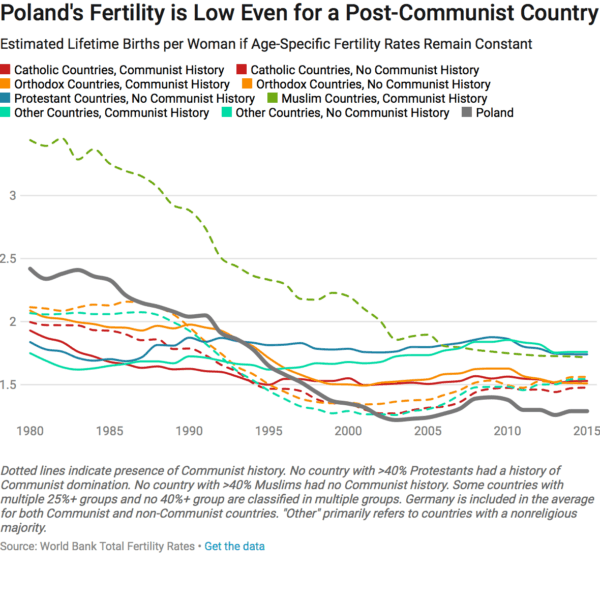Poland’s Baby Bump
Lyman Stone, First Things, March 2, 2018
In 2015, Poland’s conservative Law and Justice Party proposed a plan called “500+ Families,” which would give Polish families 500 zlotys, or about $150, per month for every child they have after their first. For a family with three children, that’s about $300 per month in untaxed cash income, or about $3,600 a year — nearly double the amount of the U.S.’s new expanded child tax credit. Poland also has a child tax credit on top of this benefit. For single parents, or for children with disabilities, the benefit may be larger, and in some cases may be claimed for the first child as well.
The purposes of the program are straightforward: to combat child poverty, and to boost Poland’s birth rate. Poland’s age-adjusted birthrate is among the lowest in Europe, a trait it shares with much of Catholic and Orthodox Europe, whereas Protestant-majority countries continue to have birthrates near demographic replacement.
So, did the program work? The government thinks so. The total number of Polish births has risen appreciably in recent years. Poland provides daily birth totals through 2016, and an annual total for 2017, which can be applied to historic seasonal variation to make an estimate of monthly births in 2017.
{snip}
{snip} There were more births in 2017 than in 2016, and more in 2016 than in 2015. But most of the increase in 2016 reflects births conceived well before the policy existed. In fact, births began rising in February of 2015, before the policy had even been proposed.
Moreover, there is a deficiency in these data: They reflect all births. The 500+ plan is not for all births — it is for second or higher parity children. So we should expect to see a disproportionate rise in those births.
Second or higher parity births rose sharply in 2016 and are now above their 2008 levels. {snip}
That said, Poland is experiencing a discernible change in its fertility trends. Age-specific birth rates are available for 2016 and can be approximated for 2017, giving us an age-controlled birth rate. This total fertility rate estimates how many children a woman who is fifteen today can expect to have over the course of her life if age-specific birth rates remain constant.
So there was a real recovery in 2016 and 2017, and it may have been helped along by the 500+ benefits.
{snip}
And it’s an expensive bump. The 500+ program pays out about $1,800 per eligible child. The average Polish worker has net earnings of only about $26,000, according to the OECD, and women’s wages are slightly below that. In other words, the benefit is equal to about 7 percent of what a worker could expect to make from working. But labor income is taxed, whereas the 500+ benefit is not, which brings the benefit to something like 9 or 10 percent of what a worker would get from the marketplace. That is, of course, in addition to other child benefits Poland provides.
{snip}
{snip} Several European countries, such as Germany and Sweden, are staving off severe fertility declines by accepting immigrants, a path Poland has eschewed. Time will tell whether Poland’s expensive bet on tight border control and moderately higher native birth rates will prove wise.
[Editor’s Note: Click on the image below to enlarge it. The original article inlcudes other graphs.]
















